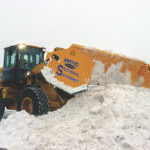Provided by the Snow & Ice Management Association
From the August 2023 Issue Of PLOW®
Sodium chloride (rock salt) is a foundational piece of an ice management strategy. But its negative impacts on the environment and infrastructure require a smart approach to using it safely and judiciously to satisfy your customers, achieve expected outcomes, manage costs, and reduce product waste.

Sell Service, Not Salt
Using salt as a profit center often leads to unnecessary applications or over-applications. Charging for salt by the application or by the amount can incentivize more salt than necessary. But you might not be making as much money as you think when you consider the impact on your equipment’s life cycle; wasted materials; and damage to infrastructure, the environment, and landscaping—some of which you may be responsible for replacing. Knowing when and how much salt to apply is necessary to achieve a successful level of service. As you become comfortable, adding alternative chlorides that can improve melting power and embracing the use of liquids will accelerate your success.
Quality, Not Quantity
Keep these strategies in mind:
Production efficiency. Setting application rates and calibrating your equipment can prevent drivers from “going rogue” or guessing. Standardize the process to measure salt output by site, across the portfolio of sites, and per storm (per site). The goal is to identify potential material waste by benchmarking actual usage vs. inventory, and to compare application rates across operators and equipment.
Storm management. Reduced consumption increases salt truck load range, which improves routing, reduces drive time for reloading, and increases service consistency. Improved material management will reduce mistakes and the possibility of running out.
Cost control. Reduce costs and inventory by using what is necessary, avoiding waste, and reducing overall material consumption.
Educate Clients
Clients may not realize they are incentivizing over-applications, which can negatively impact their budgets.
LOS requirements. Level of service (LOS) and/or client quality expectations often drive over-reliance on salt to deliver “wet” or “black pavement” conditions, particularly for “zero tolerance” clients.
Slip and fall liability. The thought that more salt means less liability also spurs over-applications. When you over-apply salt, you actually reduce its effect and create a slip and fall opportunity. The solution is greater education. It’s important for you to be knowledge- able on current ice control methods; proper use of salt; and new equipment/tech that allows superior results with less product. It’s also your responsibility to educate your client that sometimes “less is more.”
Best Practices At A Glance
Observing sustainable salt use best practices improves efficiencies, improves service, and saves money. SIMA’s Sustainable Salt Use Best Practices can guide you. What follows is an abbreviated version:
- Before deicing with a salt application, use mechanical removal to achieve as clean a scrape as possible to reduce the application needed.
- Prioritize anti-icing. Applying liquids in advance of a storm can reduce the amount of salt used and achieve longer residual than granular salt material, which can be displaced by wind, traffic, etc.
- As mentioned, owners/snow managers should establish standard application rates as well as rates for special circumstances (e.g., long-duration events, spot treatments, etc.) for operators to follow.
- Know the limits of the material you’re applying. Rock salt is only effective to 15°F. If you’re spreading untreated salt when it’s colder, you’re wasting material, time, and money.
- Optimize salt use with techniques such as blending and pre-treating, to accelerate the melting process or extend the usefulness of the application to lower temperatures.
Specific Salt Policies & Processes
Here are more SIMA recommendations on specific salt policies:
Purchasing
- Create purchasing forecasts based on minimum of five years of weather/salt usage history.
- Establish purchase agreements with multiple suppliers.
- Keep a minimum of two weeks’ worth of salt inventory in storage. Inventory should include the most efficient salt to apply/blend for use in markets that experience temperatures below 15 ̊F. (NaCl – to 15; MgCl to 5; CaCl to -25).
- Also make a commitment of a minimum of 50% of deicing material needs committed by end of Summer each season.
Storage & Transport
- Do weekly/post-storm monitoring of stored salt inventories.
- Cover all stored salt and keep it on an impervious surface, meeting local and federal requirements.
- Salt supply is stored in enclosed bins or storage containers.
- Bulk material is well covered during transport.
Operations
- Have a defined plan for ice watch/monitoring on sites, focused on spot-treating (vs. blanket) problem areas.
- Create a standard practice of clearing snow accumulations prior to salt application (plowing, blowing, sweeping, etc.).
- Design a Site Engineering Plan for strategies to minimize melt and refreeze, avoiding further applications tied to it.
- Verify any sites listed as a salt-sensitive area or zone.
- Establish a company-wide groundspeed policy for equipment in combination with establishing desired application rates.
Create A Plowing Contract That Covers Snowfall Uncertainty
A plowing contract that includes a “Readiness Fee” creates a win-win for contractors and clients by supporting business continuity, safety, and operational efficiency. Read more…
- Standardize application rate(s) across equipment types. Include tiered settings as needed calibrated with ground speed. Settings should be documented, included in all operations manuals, and incorporated into pre-season training.
- Calibrate spreaders pre-season, mid-season, and any time a change to the spreader is made (i.e. repair).
- Include basic salt usage estimate per application per site on site documentation forms.
- Create standardized monthly reporting of salt output by site and portfolio of sites, along with final seasonal reporting of total salt applied by month and season.
- Perform monthly salt output audits to verify estimated vs. actual salt used per site and compare with inventory.
- Train all spreader/salt truck operators pre-season on policies and general salt management/ice management techniques.
- Use treated salt with enhanced material to increase efficacy.
- Have an anti-icing process used to proactively prevent snow and ice bonding as defined in a snow response plan.
- Use brine (NACL, MgCL, CaCL) for anti-icing and pre-wetting.
Salt Management Technology
- Have standardized weekly and monthly reporting on salt output by site, storm, and season to benchmark.
- Participate in the Sustainable Salt Initiative (SSI), to benchmark across regional and national averages for salt.
- Use tech to track salt application /rate data. GPS enabled tracking hardware with Cloud data storage is recommended.
Find the full Sustainable Salt Use Best Practices Guide at sima.org/best-practices.
Do you have a comment? Share your thoughts in the Comments section below, or send an e-mail to the Editor at cmenapace@groupc.com.











![[VIDEO] Dickies®: Discover Workwear That’s Anything But Uniform](https://turfmagazine.com/wp-content/uploads/2023/06/1647663814-4b1a2a7742790a9b1e97a3b963477850192e1d6a9dfba9b07214a77bae25d6e3-d-218x150.jpg)




























 Create A Plowing Contract That Covers Snowfall Uncertainty
Create A Plowing Contract That Covers Snowfall Uncertainty![[VIDEO] Dickies®: Discover Workwear That’s Anything But Uniform](https://turfmagazine.com/wp-content/uploads/2023/06/1647663814-4b1a2a7742790a9b1e97a3b963477850192e1d6a9dfba9b07214a77bae25d6e3-d-324x160.jpg)